|
by Rob "Flack" O'Hara
"Double Dragon: One of the most
powerful games ever! The outstanding graphics take you through six
screens of a daring attempt to rescue a girl captured by a ruthless
street gang. Spike and Hammer are the heroes who must save the kidnapped
lady.
One player can fight alone or two players fight as a team! If play stops
before the rescue is complete, the game can be continued from that point
by adding additional coins. The graph at the bottom of the screen
indicates strength.” – Double Dragon Operating Manual
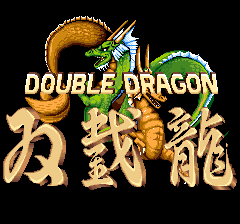 I
played my first round of Double Dragon at the AMC 10 Bowling Alley back
in 1987. Most arcade games at that time only allowed for one player at a
time, which forced players to take turns while playing games together.
In fact, for the longest time our bowling alley arcade only had one
two-player game in it (Karate Champ). Cooperative two-player games were
a relatively new concept back then. Double Dragon’s two-player mode
allowed for two friends to punch, kick and head butt side-by-side
through four enemy-infested levels. Double Dragon’s format became so
popular that it was copied hundreds of times by other companies. The
Double Dragon games themselves were converted to almost every major
gaming platform, but with MAME you can enjoy the original games
themselves. I
played my first round of Double Dragon at the AMC 10 Bowling Alley back
in 1987. Most arcade games at that time only allowed for one player at a
time, which forced players to take turns while playing games together.
In fact, for the longest time our bowling alley arcade only had one
two-player game in it (Karate Champ). Cooperative two-player games were
a relatively new concept back then. Double Dragon’s two-player mode
allowed for two friends to punch, kick and head butt side-by-side
through four enemy-infested levels. Double Dragon’s format became so
popular that it was copied hundreds of times by other companies. The
Double Dragon games themselves were converted to almost every major
gaming platform, but with MAME you can enjoy the original games
themselves.
|
Double Dragon
Technos/Taito (1987) |
In the original Double Dragon, brothers Billy (AKA Spike) and Jimmy
(AKA Hammer) have set out to rescue Billy’s girlfriend Marian who
has been kidnapped by the Black Warriors. As previously mentioned,
players can assume either the role of Billy or Jimmy, and two
players can play side by side at the same time. You’ll want to be
careful though, as players standing too close together will quickly
learn that they can inflict damage upon one another. You experience
this out a lot when one player picks up a whip.
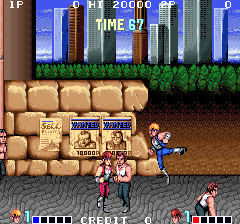 Players
have several moves in their arsenal. MAME players should be aware
that Double Dragon uses three buttons, one for kicking, one for
punching, and one for jumping. There are several other moves
available in addition to those. A double tap on the joystick in
either direction will throw a head butt. Pressing jump and then kick
will perform a jump kick, while pressing both buttons simultaneously
will launch a back kick behind you. If you manage to grab hold of an
enemy, pressing the jump button will throw them. The most important
attack to perfect is the elbow smash. By pressing jump and punch at
the same time, you will throw an elbow attack behind you. Learn to
throw your elbow and you can pretty much beat Double Dragon on a
single credit. Turn your back every time an opponent approaches.
When they walk past you in an attempt to punch you in the face,
throw the elbow. Nobody said members of street gangs were smart. Be
sure to practice your timing of this move. If you hit the buttons at
slightly different times and you’ll end up jumping in the air and
getting punched in your Double Dragon booty every time. Players
have several moves in their arsenal. MAME players should be aware
that Double Dragon uses three buttons, one for kicking, one for
punching, and one for jumping. There are several other moves
available in addition to those. A double tap on the joystick in
either direction will throw a head butt. Pressing jump and then kick
will perform a jump kick, while pressing both buttons simultaneously
will launch a back kick behind you. If you manage to grab hold of an
enemy, pressing the jump button will throw them. The most important
attack to perfect is the elbow smash. By pressing jump and punch at
the same time, you will throw an elbow attack behind you. Learn to
throw your elbow and you can pretty much beat Double Dragon on a
single credit. Turn your back every time an opponent approaches.
When they walk past you in an attempt to punch you in the face,
throw the elbow. Nobody said members of street gangs were smart. Be
sure to practice your timing of this move. If you hit the buttons at
slightly different times and you’ll end up jumping in the air and
getting punched in your Double Dragon booty every time.
Along your journey you’ll also run across several weapons that can
be used both by you and against you, including baseball bats, whips,
dynamite, and throwing knives. While none of them are as consistent
as the elbow attack, each of them offers a certain amount of
sadistic enjoyment. Like most other beat-em-up games, you can
interact with your environment in Double Dragon as well, so when all
else fails pick up an oil drum or wooden crate and smash it over
someone’s head.
 If
you notice the game slowing down or flickering when there are a lot
of enemies on the screen, this means MAME is working perfectly and
is emulating the game exactly how it ran in arcades. Maybe this is
an indication that the Black Warrior Street Gang is inside your
computer attacking the hardware as well. If
you notice the game slowing down or flickering when there are a lot
of enemies on the screen, this means MAME is working perfectly and
is emulating the game exactly how it ran in arcades. Maybe this is
an indication that the Black Warrior Street Gang is inside your
computer attacking the hardware as well.
After four levels of action (assuming you’ve either mastered the
elbow technique or have pumped a lot of credits into the game)
you’ll finally rescue Marian. If you’re playing in two-player mode
you’ll have to duke it out to determine which one of you gets to
leave with the girl, which kind of sucks if you think about it since
in the beginning of the game Marian was Billy’s girlfriend. That’s
gratitude for you. |
|
Double Dragon
Nintendo Playchoice (1988) |
Double Dragon became so popular that it was converted to many
different platforms, one of which was the NES. When Nintendo
launched their Playchoice-10 Arcade machines, the company converted
the NES version of Double Dragon and made it available for the
Playchoice-10 hardware.
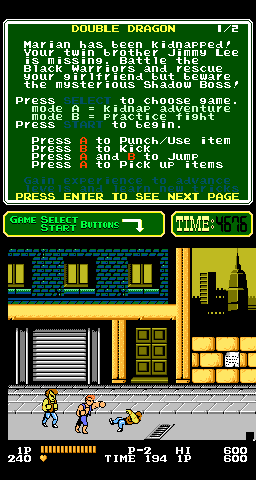 Unfortunately,
many of the cool features available in the original Double Dragon
did not appear in Nintendo’s version. The biggest feature missing
was the lack of two-player cooperative mode, which is what made
Double Dragon so unique in the first place! Without that it was
simply Renegade! Other than a two-player mode, Nintendo did a decent
job of translating the feel of the original game into their own
format. The basic idea is the same of course, but the game play is
slightly different. Unlike the original, you’ll have to earn
advanced moves by collecting hearts throughout the game. Unfortunately,
many of the cool features available in the original Double Dragon
did not appear in Nintendo’s version. The biggest feature missing
was the lack of two-player cooperative mode, which is what made
Double Dragon so unique in the first place! Without that it was
simply Renegade! Other than a two-player mode, Nintendo did a decent
job of translating the feel of the original game into their own
format. The basic idea is the same of course, but the game play is
slightly different. Unlike the original, you’ll have to earn
advanced moves by collecting hearts throughout the game.
TIP: Nintendo’s Playchoice-10 Arcade system gave players a time
limit based on the amount of money inserted. Each credit inserted
gives you 300 seconds, or five minutes. To play Double Dragon,
you’ll want to do the following. Insert several credits for
additional time. Press the minus key to select Double Dragon. Once
selected, press player one start (1 on the keyboard) to cycle
through the game’s different modes, and player 2 start (2 on the
keyboard) to launch the game. Additional time can be purchased at
any time using the credit button (5 on the keyboard).
By the way, if you thought the original version had slow down, wait
until you chug your way through this one. Woo hah! |
|
Double Dragon II – The Revenge
Technos/Romstar (1988) |
Billy and Jimmy did a good job of rescuing Marian but not such a
good job of guarding her because in the first five seconds of Double
Dragon II the Black Warriors gang shows up and shoots her! You would
think the Black Warriors would be the ONE group of people the
brothers would be looking out for! In Double Dragon II, Spike and
Hammer aren’t out for rescue. This time, they’re out for revenge.
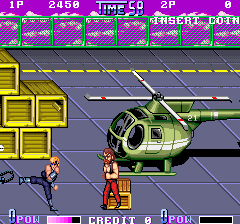 Although
the game looks similar to the original Double Dragon (with slightly
updated graphics), players will notice two things right off the bat.
First of all, Double Dragon 2 runs faster, which means you’ll have
to think faster and act faster as well. Second of all, the control
scheme has been changed. Instead of three buttons that
jump/kick/punch, you now have directional buttons. Jump is always
jump, but the button on the same side you’re facing always punches,
while the button to your backside always performs a back kick. So
the buttons are constantly swapping depending on which way you’re
facing in the game. Jump + the “back” attack button still throws the
awesome elbow, which you’ll need if you want to get very far in this
game. Although
the game looks similar to the original Double Dragon (with slightly
updated graphics), players will notice two things right off the bat.
First of all, Double Dragon 2 runs faster, which means you’ll have
to think faster and act faster as well. Second of all, the control
scheme has been changed. Instead of three buttons that
jump/kick/punch, you now have directional buttons. Jump is always
jump, but the button on the same side you’re facing always punches,
while the button to your backside always performs a back kick. So
the buttons are constantly swapping depending on which way you’re
facing in the game. Jump + the “back” attack button still throws the
awesome elbow, which you’ll need if you want to get very far in this
game. |
|
Double Dragon III – The Rosetta Stone
Technos (1990) |
In the third game of the series, Billy and Jimmy have been sent on a
quest to recover three long lost Rosetta Stones (which is odd since
the title of the game is Rosetta Stone, singular). Along with the
Lee brothers, you can purchase a whole slew of additional fighters.
Those of you with big MAME cabinets will be excited to learn that
Double Dragon III supports THREE players at a time! Those of you who
have played this game will not be so excited.
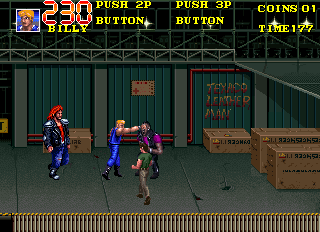 Personally,
I always liked the cartoon-like graphical style of the first two
games. In DD3, the graphics have been updated and the game begins to
look like every single other Capcom beat-em-up of that era. Personally,
I always liked the cartoon-like graphical style of the first two
games. In DD3, the graphics have been updated and the game begins to
look like every single other Capcom beat-em-up of that era.
The most annoying thing about Double Dragon 3 is its upgrade system.
At the beginning of the first level you’ll see a flashing arrow that
pointing toward the Weapon Shop. Upon entering the shop, you’ll see
what Double Dragon 3 is all about: quarters. For only one additional
credit, you can purchase extra guys, additional tricks, more energy,
or power ups. And by additional credits I don’t mean things you can
earn in the game, I mean you have to drop more virtual coins into
MAME. There’s a reason this game wasn’t very popular in arcades.
The familiar health meter from the previous two games has been
replaced by a digital readout of sorts. Each enemy attack that lands
will drop your number. Like Gauntlet, once it reaches zero it’s
lights out (in other words, you just get one man). The three-button
control scheme from the first game has returned (one button always
kicks, the other always punches) but that still won’t help you much
here. For this review I just dropped a buck’s worth of virtual
tokens into MAME, and I still haven’t beaten the first mob of bad
dudes, much less found any Rosetta Stones. In fact the only stones
I’ve found are the cobblestones which my character seems to
constantly be lying face down on every time I try to get anywhere in
this game.
Double Dragon 3 is without a doubt the most difficult and
credit-hungry game of the series. Maybe Technos was trying to
recover all the money they lost from people that beat the first two
games on only one quarter using the elbow move. |
Double Dragon (Neo-Geo)
Technos (1995) |
On the heels of the Super Mario Brothers and Streetfighter movies
came Double Dragon: The Movie, released in 1994. The following year,
Double Dragon (Neo-Geo) was released, making it (I believe) the
first game based on a movie based on a game.
 In
the Neo-Geo version of Double Dragon, the game has morphed into a
one-on-one fighting game. Players get their choice of ten
characters. Along with Billy and Jimmy, several bad guys from the
movie and previous games are available (like Abobo and Burnov) as
well as several other generic baddies you’ll recognize from the
series (like chicks with whips and ninjas). You can even play as
Marian (or technically Marian’s corpse, since she was murdered in
DD2). In
the Neo-Geo version of Double Dragon, the game has morphed into a
one-on-one fighting game. Players get their choice of ten
characters. Along with Billy and Jimmy, several bad guys from the
movie and previous games are available (like Abobo and Burnov) as
well as several other generic baddies you’ll recognize from the
series (like chicks with whips and ninjas). You can even play as
Marian (or technically Marian’s corpse, since she was murdered in
DD2).
For an MVS game, MAME handles the Neo-Geo version of Double Dragon
surprisingly well. The game contains lots of layers and moving
sprites, all of which MAME appears to be able to reproduce fairly
accurately on any semi-modern machine. Like most other MVS fighters
Double Dragon uses four buttons, so make sure your controller has
all four buttons mapped. If you’re using the keyboard, you’ll need
to use all four player keys (left ctrl, left alt, space, and left
shift) to perform your attacks.
Although it really doesn’t affect the game play, be on the lookout
for several digitized scenes from the movie that appear through the
both the game’s trailer and in the background of several scenes
within the game. |
|
As you can see, the Double Dragon series evolved quite a bit over
its eight year run. Back in the day I played a lot of Double Dragon
ports on various consoles (NES, Super Nintendo, and the Commodore
64), but now with MAME I can finally play the originals the way I
remember them. Good luck, and happy punching!
|
|
